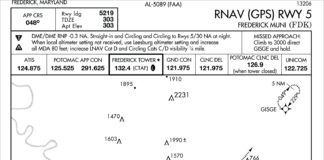For ease of presentation, we divided the required IFR reports into two main camps: IFR position reports and all the rest. All these reports are covered in the following sources: 14 CFR 91.183, 14 CFR 91.187, and AIM 5-3-2 and 5-3-3. Since required position reports are covered in 91.183(a) and AIM 5-3-2, that leaves the other sources for the additional reports.
We summarized those additional reports with the mnemonic “MARVELOUS VFR 500.” Here’s a quick recap: M is for missed approach (including your next action—return, divert, etc.). A is for an airspeed (average true airspeed) change from what you filed of 10 knots or five percent, whichever’s greater. R is for reaching a clearance limit or holding fix. V means you must report vacating a previously assigned altitude. Estimated time of arrivals must be corrected if your previous estimate will be missed by more than three minutes (only required when not in radar contact). L is for your report leaving an assigned holding fix or point. Outer markers must be reported to FSS or ATC when not in radar contact on a precision approach. Unforecast weather or any hazardous conditions must be reported, as must any Safety of flight issue. If flying VFR-on-top, you must report any altitude change. Just like our “O” above, you must report the Final approach fix if talking to ATC or FSS when inbound on a non-precision approach. Any Radio malfunctions including VHF communications radios as well as VHF and LF navigation and GPS anomalies must be reported. Last but not least, if unable to climb or descend at least 500 feet per minute, you must tell ATC or FSS.
Position Reporting
The reporting of your position when under IFR is mandated by 14 CFR 91.183—the same regulation that compels us to report unforecast or hazardous conditions and any safety of flight issues.
Specifically, Paragraph (a) states that we are to report, as soon as possible, “The time and altitude of passing each designated reporting point, or the reporting points specified by ATC, except that while the aircraft is under radar control, only the passing of those reporting points specifically requested by ATC need by reported.”
First, let’s dig down and see what the FAA is talking about when they say “reporting points.” A reporting point is defined in 14 CFR 1.1 as “a geographical location in relation to which the position of an aircraft is reported.” 14 CFR 71.5 further states that “The reporting points listed in Subpart H of FAA Order 7400.9W …consist of geographic locations at which the position of an aircraft must be reported in accordance with part 91 of this chapter.”
FAA Order 7400.9W, better known as Air Traffic Organization Policy, is an impressive tome of nearly 1500 pages that addresses countless airspace issues; however, Subpart H mercifully represents only the last 10 pages of that work and textually lists these points, categorizing them by low and high altitude and spinning Alaska and Hawaii reporting points into their own sections. It is from this reference that these listed reports can be placed on our IFR enroute charts using special symbology.
Checking the Chart Users Guide (CUG), we find nothing matching the language of 91.183’s “designated” reporting points, but do find some symbols labeled “compulsory position report.” These fix symbols—a solid black fix (triangle), solid black circle at the center of an NDB symbol, or solid black VOR, VOR/DME, or VORTAC symbol—are contrasted with the much more common symbols that aren’t filled in, which the CUG calls “non-compulsory reporting points.”
Checking one or two of the references in 7400.9W Subpart H against our Low Enroute Charts, we see that these solid symbols do represent the fixes for which 14 CFR 71.5 mandates a position report.
Now that we can guess what 91.183 is talking about, at least in part, when it mentions “designated reporting points,” we can refer to AIM 5-3-2 for further guidance about what to say and when, and whether or not these charted reporting points are the only points to which 91.183(a) applies.
Details
AIM 5-3-2 b. reminds us that the “CFRs require pilots to maintain a listening watch on the appropriate frequency and…to furnish position reports passing certain reporting points.” It goes on to state that the “designated reporting point symbol is a solid triangle and the ‘on request’ reporting point symbol is the open triangle,” and that reporting “on request” reporting points is only required at the request of ATC.
Interestingly, in using the triangle symbol only, this AIM section omits the VOR and the NDB symbols, yet the Chart Users Guide and Order 7400.9W clearly show these are compulsory as well.
Paragraph a. of AIM 5-3-2 defines more closely what 91.183 means by “passing” a designated reporting point—flip of the to/from indicator, full swing of needle, etc. AIM 5-3-2 c. 1. says to report over a compulsory reporting point when on an airway or route, even when VFR-on-top.
Since paragraph c. 3. of this section is set aside for “Flights in a Radar Environment,” we can assume that c. .1 is still referring to the non-radar flights referenced in 91.183(a). To simplify: If not in radar contact, report passing over any solid symbol on your enroute chart.
Often, the discussion of when to make position reports ends with the discussion of the solid symbols. But paragraph 5-3-2 c. 2., mandates reports over “open” symbols under certain conditions. This paragraph’s title is “Flights Along a Direct Route,” which is different than the title of paragraph c. 1., “Flights Along Airways or Routes.”
This means that c. 2. is discussing off-airway flying between two fixes. In these instances, “pilots must report over each reporting point used in the flight plan to define the route of flight.” There is nothing in there about “compulsory” reporting points, and since the CUG refers to even the open symbols as “non-compulsory reporting points,” it is quite obvious that the intent of this paragraph is to compel us to report over any fix defining a non-airway direct route, when not in radar contact.
How often do we cut a corner and file direct from a VOR to a VOR, when the airway makes a jog? Did you realize that if radar contact were lost (or never established), those two VORs would become “designated reporting points” per 91.183? Think about that next time a non-airway route is part of your flight plan. So now, in addition to having to look at your OROCA and service volumes when planning off-airway flight, you have to review your position reporting requirements as well, just in case ATC’s radar goes on the fritz. This leads us to…
“I PTA TEN P”
AIM 5-3-2 d. gives us the guidance as to what must be in our required position report. After using up a good chunk of the alphabet with MARVELOUS VFR, I feel a bit guilty throwing such an awkward mnemonic as “I PTA TEN P” at you, but here we go: Identification (as if you wouldn’t do this), Position—what is the name of the fix or naviad you’re passing, Time—Zulu time in hours and minutes please, Altitude or flight level—this includes VFR-on-top altitudes, Type of flight plan—only required for reports to FSS…not to center or approach, the Estimated Time of Arrival (ETA) over your next reporting point, the Name only (i.e. not the ETA) of the next succeeding reporting point.
The last P is for “Pertinent Remarks.” What remarks would be pertinent? Good question. Certainly if any of the required reports are pertinent—for instance, your ETA or airspeed estimates were off, or unforecast/hazardous weather was encountered—this would be a good time to make those reports.
Sometimes the reports can be combined because the triggering events are related. For instance, your TAS is off because you were granted a higher altitude. You asked for a higher altitude because of unforecast mixed icing in clouds, hence your pertinent remarks might sound like this: “I climbed to 11,000 because of moderate mixed icing at 9,000. I am on top of an undercast in VMC at 11,000.” That’s all well and good, but how does it sound in context?
Let’s say we’re flying V272 between the Sayre VORTAC (SYO) in Oklahoma and the Dalhart VORTAC (DHT) in Texas, and we’re not in radar contact. Both SYO and DHT are solid VORTAC symbols, which means they’re compulsory reporting points when not in radar contact. Groundspeed is 150 knots, which is convenient because the reporting points are 149 miles apart. Our call would be as follows: “N123AB is over SAYRE, 1545 Zulu at eight thousand feet. Estimating Dalhart at 1645 Zulu, Santa Fe next. Light rime icing at 8000 over SAYRE.”
Putting it all together
You should begin every IFR flight with the intention of making all of these required position reports, and only switch out of that mode when you hear “radar contact” associated with your call sign or aircraft identification. Keep that mode warmed up, however, just in case radar contact is lost.
Remember, just because your L-chart doesn’t have any solid fixes or navaids on it, doesn’t mean position reports won’t be required in a radar outage. Any off-airway route requires that the reporting points used to define the direct route be treated as compulsory.
After the last three clinics, you should be proficient and comfortable making all the required IFR reports mandated by the CFRs and the AIM.
Evan Cushing is a former regional airline training captain who now is mandated to report arriving at his desk at an aviation university.





SO SO helpful. Thanks!